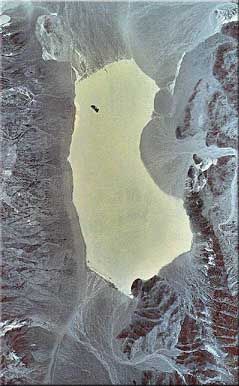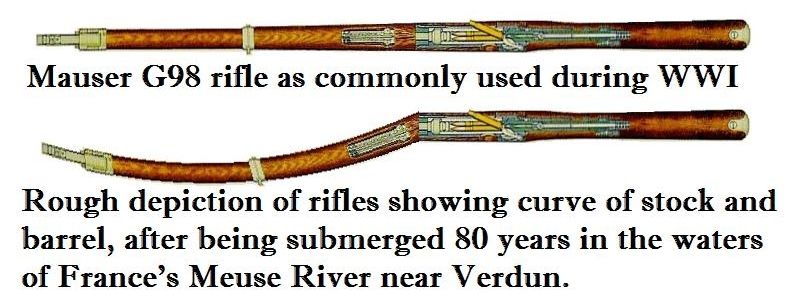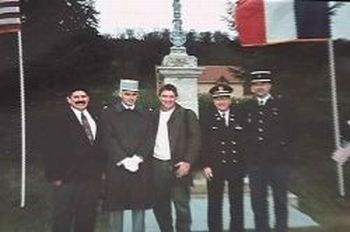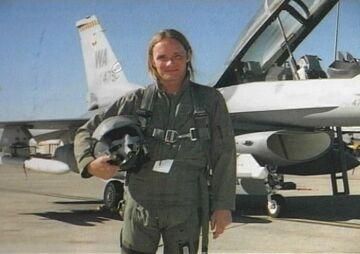
Publisher:
Bonnie King
CONTACT:
Newsroom@Salem-news.com
Advertising:
Adsales@Salem-news.com

~Truth~
~Justice~
~Peace~
TJP
Jan-03-2012 03:03


 TweetFollow @OregonNews
TweetFollow @OregonNews
Mysteries of Unseen Force: Racetrack Playa's Sliding Rocks & River-Curved Rifles in France
Tim King Salem-News.comGeophysics rendezvous with aerodynamics in Death Valley, possibly solving the 'traveling rock' mystery; while recovered war relics in France defy explanation...
 Mysterious Roving Rocks of Racetrack Playa. Photo credit: NASA/GSFC/Cynthia Cheung |
(SALEM) - What elements in nature move solid objects with silent, unseen force?
- How can rocks slide through the desert leaving distinct trails in their wake?
- How can metal and wood forged and machined for war bend from a river current?
These questions form the basis of this article about seemingly unnatural occurrences, that may not be such a mystery after all in one of the two above, described events.
Recently while examining National Geographic images of dark dolomite boulders that seemingly cruise around with no visible means of propulsion in a part of Southern California's Death Valley called 'Racetrack Playa'... leaving tracks no less, I tried to imagine wind moving rocks hundreds of feet, even farther. In some cases they weigh hundreds of pounds!
 Racetrack Playa from space - Wikipedia |
Theories of the rocks somehow containing magnetic properties were shot down in flames when scientists declared that all were just simple, ordinary rocks, not extraordinary in any way. Occasional accumulations of water that move quickly could provide part of the answer, but only in particular areas.
These otherwise ordinary, non-stationary stones, leave an unmistakable trail on the dry lake bed, which is almost as flat as a board, with only two inches of height difference between the valley's north and south ends, which span about four kilometers, or two and a half miles.
The dry lake exists between the Cottonwood Mountains to the East and the Last Chance Range to the West. At the north end is a rock formation known as the Grandstand, from which other rock formations break off and fall onto the lake bed.
In an article titled Sliding Rocks on Racetrack Playa, writer Dennis Brooks with the Website Digital-Desert, claims to have the solution:
| “ |
The rocks slide across the playa on a sheet of ice with the help of aerodynamic forces, which are produced by natural wind tunnels. |
” |
You can follow the link above to his story to learn more. What Brooks proposes I agree with in part, however the aerodynamics I associate with the moving rocks; that is where the mystery in my opinion, takes an unnatural turn. In qualifying that point, I do not reference unnatural with regard to the paranormal, but toward man and one of man's fastest moving achievements.
There are many theories as expected, but in the end there is no conclusive data establishing once and for all just how these rocks manage to wander. The fact remains that nobody knows why and at this point, it still leaves experts and theorists scratching their heads. Without question, wind is considered the most likely suspect in this mystery of apparent rock propulsion, but how and why?
Government and Academic Research
A NASA press release titled: NASA Studies the Mystery of Racetrack Playa's Sliding Rocks - geology.com issued in August 2010, explains that researchers have documented these tracks or trails since the 1940s, back in the time that jet fighters first blasted across these skies spanning Nevada and California, which is a common practice today.
Seventeen undergraduate and graduate students from the Lunar and Planetary Sciences Academy (LPSA) at NASA's Goddard Space Flight Center in Greenbelt, Maryland, traveled to the Racetrack and nearby Bonnie Claire playas two summers ago, to investigate how these rocks move across the nearly empty flats.
 |
|
The rocks on Racetrack Playa in Death Valley, Calif., move across the flat, |
Some of the rocks that have moved weigh less than a pound, however some weigh between 25-30 pounds. One of the largest sliders, named 'Karen', reportedly weighs in at an estimated 700 pounds.
There is no question that a powerful force would be required to move rocks that big, and the obvious candidate NASA says, is the fierce playa wind.
"It's surprising when you see how big some of these boulders are," says Andrew Ryan of Slippery Rock University in Slippery Rock, Pennsylvania, who gives talks on the Playa Racetrack.
He says there is even a consensus that they move uphill
Wind speeds of 150 miles per hour or more would probably be necessary to move most of the rocks. The wind speeds that graze the playa's surface are very fast, but not that fast, so the newer studies tend to ask how the friction between the rocks and the clay might be reduced.
There are many theories; some deal with glaciers, others suggest that the rocks move as fast as people walk, however no one has ever witnessed this happen.
I have a feeling I know exactly what makes the rocks in Death Valley's Racetrack Playa move and I will get to that in a moment, however another mystery I came across once that also deals with movement, to this day remains absolutely unresolved.
I never did figure out what happened to several evenly bent World War one rifles that I saw in France a few years ago, that had been pulled out of the Meuse River near the historic city of Verdun after roughly 80 years in that mighty waterway that slices though this ancient city.
Mystery of the Curved War Rifles
 - by Tim King |
My friend Jean Paul de Vries, lives in Romagne-sous-Montfaucon, France. This is a beautiful region today that hides its past of having been ravaged and desecrated by the first World War. Hundreds of thousands of combatants and civilians died in fierce fighting during what many viewed at the time, and even more now in retrospect, as a terrible war of attrition with no winners and no losers.
"The Great War" as it is known, stole millions of lives and left behind hundreds of thousands of corpses, most of which would be gathered after the war ended by peasants, and placed in above-ground 'ossuariums'. Along with the dead lay the wreckage of violent war, which includes unexploded land mines and other deadly bombs that still kill French farmers in this day and age, as they plow their fields that were a little less than a century ago, battlefields.
 Tim King (center) flanked by French officials and |
The rifles, which as I recall were German Mauser bolt-action types, were amazing to look at. Each rifle, forward of the center, was clearly bent. I thought they were in remarkably good condition, considering where they had spent approximately eight decades.
What fascinated me in particular, was the fact that in each case, the various rifle's metal and wood had bent or curved, evenly, which seemed to preclude the idea of the weapons having been melted in a fire. The bent or curved wood, along with the metal, was in surprisingly good shape.
Jean Paul has an amazing display of First World War artifacts that are all collected from the battlefields legally and contained in a secure, private museum. It is an extraordinary and mind blowing experience to enter this place, housed in a building that the Germans almost leveled in WWI. Jean Paul and his wife Bridgette have pictures of their place before the war, during WWI, shattered and almost all of the roof missing, and then after it was rebuilt around 1920.
My father, the late Charles King, spent his lifetime working in metals and knew a great deal also about wood construction. He restored antique cars and other mechanical devices and part of his work involved rebuilding wooden wheels and other objects that required the complex and precise bending of wood.
I don't know what type of wood the Mauser was built with, but I suspect it was something like Black Cherry, a frequent pick for rifle builders, which is an extremely hard wood. My dad's reaction was that the water of the river would never have produced enough force to bend the rifles as far as they were, in that period of time, if it were possible at all.
I can say that the Meuse River is a mighty, fast-moving body of water, and my impression was that if any river could bend a rifle, the odds are the Meuse would rank among them. However I know nothing about this science and always suspected that my father was correct.
However, other discussions about this over the years have brought other theories. One friend who is an accomplished archaeologist, told me he thought the river current could indeed have bent the rifles. I will be curious to see what theories may emerge in comments below.
The rifles leave me stymied, I can not even begin to answer the question of how and/or why such a strange event could have taken place, however I will share my theory of what moves those darned rocks in Death Valley.
 |
Aerodynamics Push Geophysics in Death Valley
There is no question that geophysicists know their stuff, the Wikipedia's page regarding the field states:
- Geophysics is the physics of the Earth and its environment in space; also the study of the Earth using quantitative physical methods...
- ...its dynamics and their surface expression in plate tectonics, the generation of magmas, volcanism and rock formation.
An equally impressive field of research, the study and development of Aerodynamics as described by Wikipedia:
- Aerodynamics is a branch of dynamics concerned with studying the motion of air, particularly when it interacts with a moving object...
- ...Understanding the motion of air (often called a flow field) around an object enables the calculation of forces and moments acting on the object. Typical properties calculated for a flow field include velocity, pressure, density and temperature as a function of position and time.
While each group contains large numbers of bright people, I suspect they have not connected over the issue of moving rocks in Death Valley's Racetrack Playa. And perhaps, a number of people who happen to work for the U.S. Air Force, could offer thoughts on those moving rocks and their relationship to aerodynamics.
 Tim King shortly before flying in the F-16 |
In 1999 I had the most amazing opportunity as a reporter- to climb into the back seat of an Air Force F-16 Falcon for something known as an incentive flight.
After a flight physical very early in the morning, and a few hours of training, we walked out to the flightline and finally climbed aboard the jet fighter, taxied to the runway, and lifted off the ground when our airspeed reached 175 miles an hour.
The next hour and fifteen minutes were spent flying over Death Valley in one of the most amazing experiences I could ever describe.
I noticed this day that we needed to attain permission to visit specific areas that were over Death Valley, and I assume that when the university team was investigating this site, that it was well known and that if jet pilots do frequent this area, that they would have avoided it during this period.
Possibly the most unforgettable part was flying the F-16 at 500 miles per hour, at fifty feet below sea level. That placed us exactly fifty feet in the air, it was breathtaking.
This particular site, where the ground is actually a full hundred feet below sea level, is not the racetrack, which sits 3608 feet (1130 m) above sea level, but it is Death Valley and the Air Force flies over a wide region here. The F-16 that I flew in was part of the Red Flag Fighter Weapons School at Nellis Air Force Base in North Las Vegas, Nevada.
My background includes working in flightline operations at Marine Corps Air Station El Toro, and I am very familiar with the blast associated with jet engines. It is serious and I can't imagine how any rock we passed over that day at 500 miles per hour, 50 feet above the deck, could have been any less moved by the experience.
The fact that the rock trails only came into focus in the 1940's, as referenced earlier, also allows for the plausibility of jet/rock propulsion.
I've included this video which shows the first U.S. manned jet aircraft and the year is 1942. The Army Air Force became the United States Air Force in 1947, at a point when the Cold War was heating up, and burning away any question of the jet fighter's birth as the new aerial weapon of war.
Jets were being produced increasingly from the late 1940's and the progress in honing these high tech war machines has never abated.
People weren't sleeping in this regard prior to the 40's; history and nature enthusiasts, photographers, explorers, and the ever-so-curious massive population of nearby Los Angeles, has always supplied large numbers of people happy to venture into these areas.
Two of those people doing this as early as 1940, were my parents. My mom, Nellie King, accompanied my dad Charles on many memorable trips and Death Valley was a frequent destination. My dad's good friend from childhood, whose first name was Dexter, was the Death Valley Postmaster for many years.
 |
FOD Patrol
In Marine Corps aviation, and I'm sure this holds true across the board in all jet operations, it is extremely important to ensure that the flightlines are clean because small objects can be sucked into jet engines, and also because the blast from a jet can turn small objects into flying projectiles.
We had to perform foreign object debris (FOD) patrols every day; Marines walking across the flightline side by side trying not to miss an inch of ground.
Knowing that the jet blast can be serious while planes are parked on the ground or taxiing at low speed, I can only imagine the force they emit when flying hundreds of miles per hour just above the ground.
Of course I know I don't specifically know if this area is authorized for jet flights, but concluded quickly that it is, after a search on Google pulled up this video: Jets over Racetrack Playa. You can visit the page to see the video, the planes are not flying excessively low, but I happen to know for a fact that they can.
Take your time and explore the Racetrack Playa below, courtesy of Google Maps and Zee Maps (story continues below)
Bermuda Triangle |Mexico City| Racetrack Playa | Lake Toplitz | Marfa Lights | Area 51
It is true that we lack answers, but sometimes this society we exist in benefits the most when we simply accept what is obvious, and if that is the case in this event, the lesson is that academic researchers in particular may not adequately correlate their findings outside of immediate circles.
Maybe I'm right, perhaps I'm way off base, but it seems that jets could easily send even heavy rocks skidding along the flat dry lake bed without any difficulty if the planes are flown low and fast enough.
I can't put my hand on either at this moment, but I have video of both the rifles that I mentioned, and the entire F-16 flight. Perhaps I can unearth both soon and these visual tools can expand our ability to explore these ideas. Most importantly, I want to clearly state that I am not an expert in any of these areas, except perhaps jet operations to a certain extent.
I am compelled by the possibility that flight could be the key in unlocking an otherwise astounding mystery, considered by at least one online site to be one of the world's ten most mysterious occurrences. Perhaps the moving rocks will always leave people in a quandary, or maybe afterburners, fighter jocks and low altitude have something to do with it, and that breakdown between the experts who study rocks and those who study flight, is very real.
_________________________________________________________Tim King: Salem-News.com Editor and Writer
Tim King, summer 2008, covering the Iraq War
Tim King has more than twenty years of experience on the west coast as a television news producer, photojournalist, reporter and assignment editor. In addition to his role as a war correspondent, this Los Angeles native serves as Salem-News.com's Executive News Editor. Tim spent the winter of 2006/07 covering the war in Afghanistan, and he was in Iraq over the summer of 2008, reporting from the war while embedded with both the U.S. Army and the Marines. Tim is a former U.S. Marine.
Tim holds awards for reporting, photography, writing and editing, including the Silver Spoke Award by the National Coalition of Motorcyclists (2011), Excellence in Journalism Award by the Oregon Confederation of Motorcycle Clubs (2010), Oregon AP Award for Spot News Photographer of the Year (2004), First-place Electronic Media Award in Spot News, Las Vegas, (1998), Oregon AP Cooperation Award (1991); and several others including the 2005 Red Cross Good Neighborhood Award for reporting. Tim has several years of experience in network affiliate news TV stations, having worked as a reporter and photographer at NBC, ABC and FOX stations in Arizona, Nevada and Oregon. Tim was a member of the National Press Photographer's Association for several years and is a current member of the Orange County Press Club.
Serving the community in very real terms, Salem-News.com is the nation's only truly independent high traffic news Website. As News Editor, Tim among other things, is responsible for publishing the original content of 101 Salem-News.com writers. He reminds viewers that emails are easily missed and urges those trying to reach him, to please send a second email if the first goes unanswered. You can write to Tim at this address: newsroom@salem-news.com
 End Israeli apartheid |
Articles for January 2, 2012 | Articles for January 3, 2012 | Articles for January 4, 2012


Quick Links
DINING
Willamette UniversityGoudy Commons Cafe
Dine on the Queen
Willamette Queen Sternwheeler
MUST SEE SALEM
Oregon Capitol ToursCapitol History Gateway
Willamette River Ride
Willamette Queen Sternwheeler
Historic Home Tours:
Deepwood Museum
The Bush House
Gaiety Hollow Garden
AUCTIONS - APPRAISALS
Auction Masters & AppraisalsCONSTRUCTION SERVICES
Roofing and ContractingSheridan, Ore.
ONLINE SHOPPING
Special Occasion DressesAdvertise with Salem-News
Contact:AdSales@Salem-News.com



Terms of Service | Privacy Policy

All comments and messages are approved by people and self promotional links or unacceptable comments are denied.
Oklahoma J. Hill November 21, 2012 6:36 pm (Pacific time)
My theory blows your theory outta the Valley. First off, a jet engines force, As you should know would not only bake mud to boiling point but the thrust alone would blow mud into the next valley. and, how do you get the rocks out far away from the fans edge before your game of stoop-ball can begin.
Karl Hille January 13, 2012 12:59 pm (Pacific time)
Good theory, and it shouldn't be too hard to simulate, though I'd think you might need more, like wet conditions. Seems like otherwise, you would just send rocks skittering or jumping (friction) rather than sliding. But I don't know how long rain would stay wet in this area.
Tim King: Thanks Karl, I agree it is a bizarre scenario to attempt to resolve... I fully agree, it seems like the planes might just blow the rocks across the lake bed, perhaps it is a combination of the jets passing after rains, I admit I am fascinated by it, thanks for the comment.
Geo Dan January 3, 2012 11:05 am (Pacific time)
Sounds like a viable theory for the Racetrack rocks, hard to say but why not?
[Return to Top]©2025 Salem-News.com. All opinions expressed in this article are those of the author and do not necessarily reflect those of Salem-News.com.